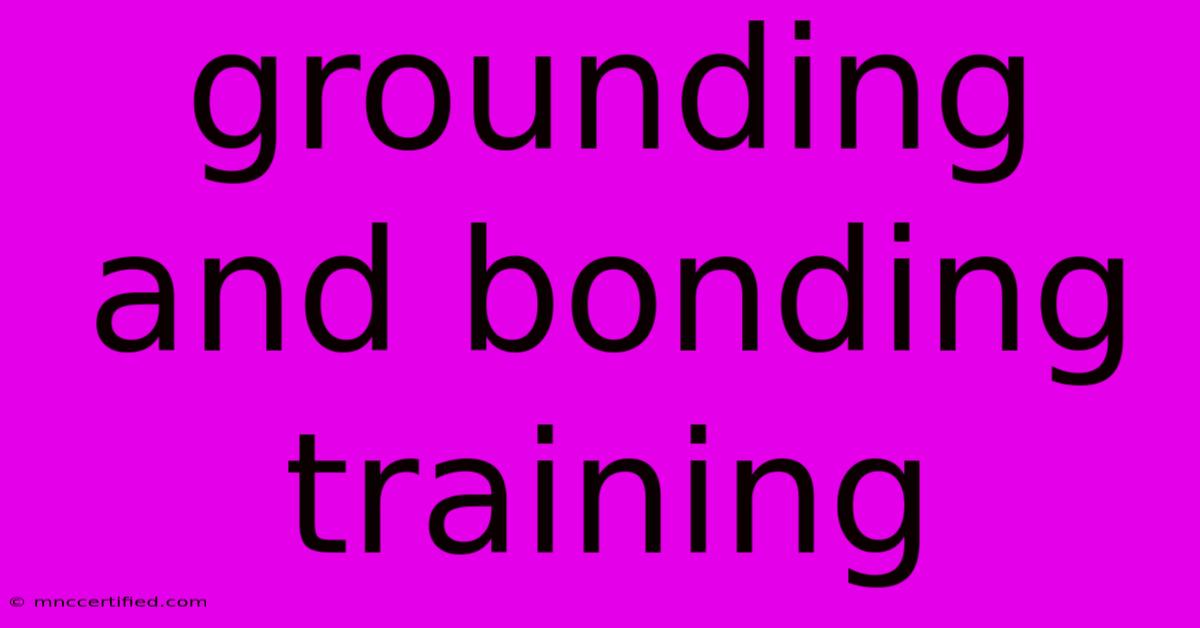Grounding And Bonding Training

Table of Contents
Grounding and Bonding Training: A Comprehensive Guide for Electrical Safety
Grounding and bonding are crucial electrical safety measures often misunderstood. Proper grounding and bonding training is essential for electricians, engineers, and anyone working with electrical systems. This comprehensive guide explores the importance, techniques, and regulations surrounding grounding and bonding. We'll cover everything you need to know to ensure a safe work environment and compliant installations.
What is Grounding?
Grounding, also known as earthing, connects a non-current-carrying metallic part of an electrical system to the earth. This connection provides a low-resistance path for fault currents to flow safely to the ground, preventing dangerous electrical shocks and equipment damage. The primary purpose of grounding is safety.
Types of Grounding Systems:
- Grounding electrodes: These are conductive rods or plates driven into the earth to establish a reliable ground connection. The type and number of electrodes depend on soil conditions and local regulations.
- Grounding conductors: These are wires connecting the grounding electrodes to the electrical system. They must be appropriately sized to handle fault currents.
- Equipment grounding: This connects the non-current-carrying metallic parts of equipment to the grounding system. This protects users from electrical shock if a fault occurs in the equipment.
What is Bonding?
Bonding connects two or more metallic parts together electrically. While grounding connects to the earth, bonding connects different parts within a system. The main goal of bonding is to equalize the electrical potential between various conductive parts. This prevents voltage differences that could cause dangerous electrical shock hazards.
Types of Bonding:
- System bonding: This connects all metallic parts of an electrical system to equalize their potential.
- Equipment bonding: This connects the metallic parts of various pieces of equipment within the system.
- Supplementary bonding: This is used to enhance safety in specific situations, such as connecting metallic pipes or enclosures to the grounding system.
Why is Grounding and Bonding Training Essential?
Proper grounding and bonding are critical for:
- Preventing electrical shocks: Grounding and bonding provide a path for fault currents to flow to the earth, minimizing the risk of electrical shock.
- Protecting equipment: By diverting fault currents, grounding and bonding protect expensive equipment from damage.
- Ensuring compliance: Electrical codes and regulations mandate specific grounding and bonding requirements to ensure public safety. Failure to comply can result in penalties and legal liabilities.
- Minimizing fire hazards: Fault currents can generate significant heat, leading to fires. Proper grounding and bonding significantly reduces this risk.
Key Aspects Covered in Grounding and Bonding Training:
A comprehensive grounding and bonding training program will cover:
- Electrical theory: Understanding the fundamentals of electricity is essential for grasping grounding and bonding principles.
- National Electrical Code (NEC) and other relevant regulations: Training must emphasize adherence to local and national electrical codes.
- Grounding electrode system design: This includes selecting appropriate electrodes, determining the required number, and ensuring proper installation.
- Grounding conductor sizing and installation: Proper sizing and installation are critical to ensure the effectiveness of the grounding system.
- Bonding techniques and methods: Training covers various bonding methods and their applications.
- Testing and inspection procedures: Learners will learn how to test and inspect grounding and bonding systems to ensure they are functioning correctly.
- Troubleshooting and problem-solving: Identifying and resolving issues in grounding and bonding systems are vital skills.
- Safety precautions: Emphasis will be placed on safe work practices when working with electrical systems.
Finding the Right Grounding and Bonding Training:
Look for training programs accredited by recognized organizations and offered by experienced instructors. Verify that the course covers all the relevant aspects mentioned above. Consider online courses, workshops, or on-the-job training programs depending on your learning style and needs.
Remember: Grounding and bonding are not interchangeable. Both are vital for a safe and compliant electrical system. Investing in proper training is an investment in safety.
SEO Optimization Considerations:
This article incorporates several SEO best practices:
- Keyword optimization: The article naturally integrates relevant keywords like "grounding," "bonding," "electrical safety," "NEC," "grounding training," "bonding training," and related terms throughout the text.
- Header structure: The use of H2 and H3 headings creates a clear structure, improving readability and SEO.
- Bold text: Important terms are highlighted using bold text to improve readability and keyword emphasis.
- Readability: The writing style is clear, concise, and easy to understand, enhancing user engagement and SEO.
- Content length: The article is sufficiently detailed to provide comprehensive information, satisfying user intent and improving search ranking potential.
By consistently implementing these SEO techniques, you can enhance your website's visibility and attract more organic traffic. Remember, creating high-quality, informative content is paramount for successful SEO.

Thank you for visiting our website wich cover about Grounding And Bonding Training. We hope the information provided has been useful to you. Feel free to contact us if you have any questions or need further assistance. See you next time and dont miss to bookmark.
Featured Posts
-
British Man Held By Russian Forces
Nov 26, 2024
-
East India Trading Company Coin
Nov 26, 2024
-
Tourist Boat Sinks Off Egypt 16 Missing
Nov 26, 2024
-
Central Ohio Insurance Services
Nov 26, 2024
-
Adele Sends Emotional Message Son Fiance
Nov 26, 2024